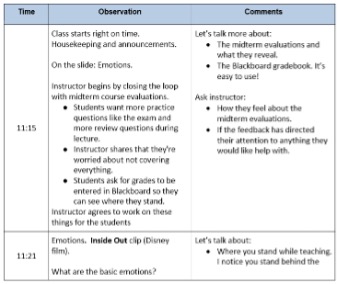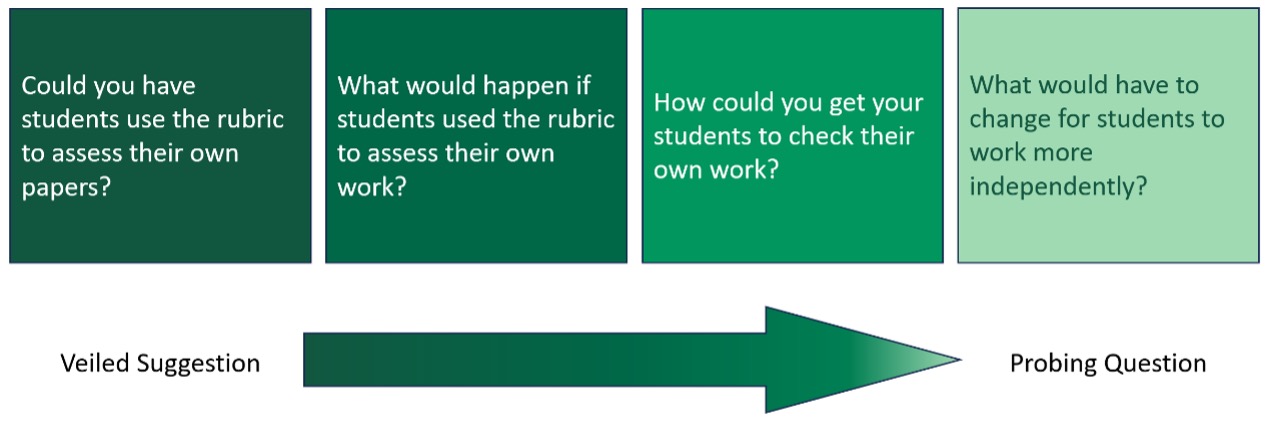Teaching Observations
What is a teaching observation?
Teaching observations are collaborative and formative processes where educators observe each other's teaching methods and interactions in order to provide constructive feedback. It's an opportunity for mutual professional development, fostering an environment of continuous improvement and sharing of best practices among educators. It is designed to provide another form of feedback beyond the student ratings of instruction.
The TLC has introduced a Mastering Peer Observation of Teaching medallion for anyone wanting to perform teaching observations. Note: This does not replace the Peer Review of Teaching processes in the colleges. See Interested in Being a Teaching Observer below if you are interested in participating.
- Enhancement of Teaching Skills: Observers can learn new teaching strategies or see different ways to engage students, which they can then incorporate into their own practice.
- Feedback from Colleagues: Educators receive valuable insights from peers who understand the challenges of teaching and can provide targeted advice.
- Reflective Practice: It encourages self-reflection on one’s own teaching as both observer and observed, leading to personal growth.
- Promotion of Collaboration: Builds a sense of community among faculty, promoting a culture where teachers work together towards common goals.
- Professional Growth: Contributes to the professional development requirements that many institutions have for their faculty.
Teaching Observations are not just about finding areas for improvement; it's also about recognizing and affirming what is working well in the classroom. By engaging in this process, educators demonstrate a commitment to excellence in teaching and learning within their institution.
“Our jobs as (observers) is to serve as the educator’s ‘teaching friend,’ offering a perspective outside the educator’s own experience of the course. As we do so, we eschew positioning ourselves over the educator we are (observing) and instead sit beside them, celebrating strong teaching moments and collaborating to solve teaching problems. The idea is to take the fear and anxiety out of peer (observation) and replace it with warm, collegial support so that we can all grow and get better at what we do in the classroom.” (Indiana University Faculty Academy on Excellence in Teaching)
- Every educator can learn and benefit from observing and being observed.
- There are many ways to teach well.
- The process can be filled with anxiety, both by the observer and the observed.
- Be aware of your personal biases or judgments.
- Build on strengths.
- Feedback should be timely and thoughtful.
- The goal is to determine if the teaching is effective, not whether it conforms to your experiences.
Step 1: Meet with the Instructor
There are several goals for the first meeting:
- Develop a level of familiarity and comfort between the observer and the instructor.
- Develop an understanding of the instructor’s teaching philosophy.
- Ask instructor their priority areas for the observation.
- Discuss situational factors to understand the context in which the course is being
taught
- Nature of the subject
- Characteristics of the instructor
- Characteristics of the students
- Review the syllabus, paying particular attention to course learning outcomes, course structure, how activities and student assessment align with the learning goals.
- Agree on the best session(s) to attend.
Step 2: Attend the Class
- Arrive to class ahead of time so as to not create a distraction by a late entrance
- Sit somewhere that is not distracting to the students nor the instructor (the back row is usually good)
- Observe what the students are doing
- Stay for the entire class
- Don’t intervene in the teaching during the observation
- Create a log of the class session, including observations, impressions, and questions, both verbal and non-verbal
What to observe:
Instructor
- Organization and clarity. Clear explanations, clear organization of the class, good use of class time.
- Active Learning. Well-designed in-class activities to promote learning; good balance and interpolation of lecture and activities; effective facilitation of group work.
- Voice quality and presentation. Appropriate variation in volume and inflection of speech; little use of filler words such as “um” or “you know”.
- Classroom management. Efficient handling of housekeeping issues; awareness of student behaviors that could be distracting; engagement of all students in discussions and activities.
- Teaching practice. Appropriate pacing of presentation; effective use of technology; good use of examples; awareness of students’ level of understanding; respect toward students, including respectful listening; welcoming of multiple perspectives.
Students
- Preparation. Indications that students have done assigned work to prepare for the class.
- Engagement. Note-taking; absence of texting or other electronic distractions; participation in class discussion, group work, and other activities
- Attitude. Timely arrival; greeting or chatting with the instructor before or after class; attentiveness; positive attitude toward class and subject
- Balance of student participation. Appropriate demographic balance in who speaks in class
- Civility. Respect toward the instructor and other students; attentive listening; avoidance of distracting activities
Sample Log

Step 3: Post-Observation Meeting
- Meet within a week of observation
- We are peers, not superiors sent to judge
- Keep in mind areas the instructor asked you to focus
Meeting agenda:
-
-
-
- Establish a connection.
- Ask instructor how they thought the class went
- Ask clarifying questions
- Highlight strengths
-
-
“You connect so well with your students. They are with you throughout and very attentive to your teaching. I notice that whenever you called on student, you used their names. Kudos!”
-
-
-
- Surface areas of concern with observation data
-
-
“You did a great job asking students some very interesting questions throughout your lecture, but I noticed that most of the time you waited for a few seconds and then answered your own questions. Let’s see if we can find a way to get students to respond to your questions so you don’t have to do all the work.”
- Ask probing questions but not veiled suggestions.

Examples of probing questions:
-
-
- Why do you think this is the case?
- What would it look like if…?
- What do you think would happen if…?
- What would excellent/superior work look like for you?
- What’s another way you might…?
- What would have to change in order for?
- What was your intention when?
-
It is important that feedback be structured in a way that is helpful yet affirming. Below are some resources that provide useful information on how to give feedback to the instructor being observed. Although they are geared towards giving feedback to students, there are useful strategies that can be applied also to giving feedback to those being reviewed.
Resources
- Effective Feedback resource page
- Webinar: Effective Feedback and Evaluation: Best Practices for Improvement. Devin Scott and Dr. Amy Hall. October 2020.
Specific tips
- Provide tangible feedback.
- Don’t be vague.
Say more than “Great job” or “Pleasure to work with.”
- Attack issues not people.
Avoid comments such as “You’re too shy or too OCD.”
Ask-Tell-Ask Method for Giving Feedback
- Ask: Question to trigger self-reflection
- How did “…” go for you?
- Please reflect on “…”?
- Tell: Relay Observations (concrete and specific)
- Positive
- Constructive
- Ask: Question about changes and/or help
- What do you see as priorities for improvement?
- Who/what might help you with this change?
- Be sure to keep conversations completely confidential.
- Offer to observe additional classes or to provide additional feedback if requested.
- Perhaps offer to have the instructor come to observe one or more of your classes.
Being a teaching observer is also a way to improve teaching as it gives you insight into other teaching strategies and allows you to engage in conversations with fellow educators about effective teaching and learning strategies. The Teaching and Learning Center has an online course that provides the resources to be a teaching observer. Once you complete the course, your information will be available on this page to be selected by someone seeking an observation. There is no obligation to participate, although you should let us know if you are no longer interested.
The certification course is part of the TLC's medallion program. It has three required and two optional modules:
- Performing a Teaching Observation
- Enriching Your Review
- Considerations for Writing Observation Reports
- Considerations for Online Courses (optional)
- Considerations for Clinical Courses (optional)
With approval from your department chair, send an email to tlc@uthsc.edu if you are interested in getting started.
Some of the content on this resource page is from Indiana University's Faculty Academy on Excellence in Teaching.
Chism, N. V. N., & Chism, G. W. (2007). Peer Review of Teaching: A Sourcebook. Anker Pub. Co.
